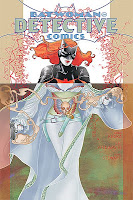You are warned, here be spoilers.
Any ambivalence I’ve had about the plot of Detective Comics, over the last few issues, has surely been due to my having jumped in in the middle of an arc. I’ve been intrigued by the characters, blown away by the art, but been merely… warily curious… about the story.
This issue drew me in with its story – with its events and its revelations. Some of that drawing-in is the art, but it’s art feeding off the story – with this issue, Rucka’s given Williams scenes to justify drawing spectacle.
There’s no more hinting, no more plotting – just execution, action and reaction. Alice, the wonderfully elegant and wonderfully creepy villainess of the piece, carries out a daring heist, and Batwoman has to chase her down. This entails, among other things, racing dramatically on her batcycle, and leaping from one airplane to another. In mid flight. And not some sort of short “come on, you can make it” running-long-jump leap either; this is a jump down, from a pursuing plane to its quary. And I don’t see her cape doing anything particularly glider-y, either. Batwoman has balls.
I love the practicality of Batwoman’s costume design. She has gloves with spikes along the forearms, like Batman, but where the gloves themselves look to be thin enough to allow for fine manipulation, the forearm piece thickens into hard braces – probably providing her with both armour and with a proper anchor for the spikes. And her boots, while dramatically long, don’t quite reach her knees, and from beneath you can see they have good combat-boot tread. I’m not sure if this is all Rucka’s or Williams’s attention to detail, but I love it.
Kate Kane – Batwoman – is an enigma, one I’m finding fascinating. She doesn’t grandstand like Superman or Wonder Woman. She doesn’t even brood dramatically like Batman. She just gets on with it.
I’m not exactly a lone voice in the darkness about J. H. Williams III’s art. I’ve been hearing praise for his work from all quarters in reference to this series, and it’s very well earned. I mentioned in my review of issue #856 that the art has a somewhat painted look I normally associate with Marvel; I’m more certain now in my feeling that what Williams has produced is what most artists are trying for when they work in this style. His paneling is wild, often crooked, often jagged, making liberal use of panels scattered across larger illustrations like so many puzzle pieces, but it’s never confusing, never jarring.
This series is a wonderful read so far, and I dno’t foresee putting it down any time soon.
